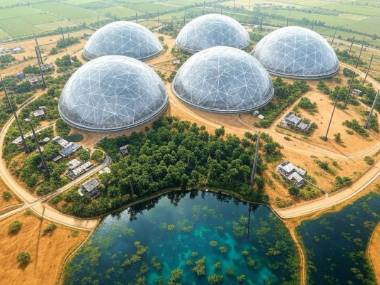Multi-Biome Geodesic Colony
Multi-Biome Geodesic Colony Specification
Project Overview
- Name: Multi-Biome Geodesic Colony
- Purpose: To create a sustainable, self-sufficient habitat that supports diverse ecosystems under controlled conditions.
Location
- Site Selection: Ideal locations include areas with moderate climate conditions, access to water, and lower seismic activity. Specific site pending further geological surveys.
Design Specifications
Geodesic Domes
- Material:
- Primary Structure: Aluminium or steel frame for strength and lightweight.
- Covering: Transparent, durable polycarbonate panels with UV protection for maximum sunlight penetration.
- Sizes:
- Small Domes: 10-20 meters in diameter for specialized micro-ecosystems.
- Medium Domes: 30-50 meters for general living areas, agriculture, and research.
- Large Domes: 70-100 meters for expansive biomes like forests or water bodies.
- Climate Control:
- Temperature Regulation: Integrated heating and cooling systems, possibly geothermal or solar-powered.
- Humidity Control: Misting systems for humid biomes, dehumidifiers for arid zones.
- Air Circulation: High-efficiency fans and air filters to manage CO2 levels and ensure air quality.
Biomes
- Tropical Rainforest Dome:
- Climate: Warm, humid with daily rain simulation.
- Flora: Diverse plant species including bromeliads, orchids, and large trees.
- Fauna: Adapted to high humidity, like amphibians, birds, and certain insects.
- Desert Dome:
- Climate: Hot and dry with minimal moisture.
- Flora: Cacti, succulents.
- Fauna: Reptiles, insects adapted to arid conditions.
- Temperate Forest Dome:
- Climate: Cooler, with distinct seasonal changes.
- Flora: Deciduous trees, ferns, mosses.
- Fauna: Mammals, birds suited to temperate climates.
- Aquatic Dome:
- Climate: Controlled water temperature with artificial light cycles.
- Flora: Aquatic plants, algae.
- Fauna: Fish, crustaceans, amphibians.
- Living Quarters and Research Dome:
- Climate: Human-optimized for comfort.
- Purpose: Residential, research labs, educational facilities.
Sustainability Features
- Energy: Solar panels integrated into dome surfaces, wind turbines, potential for small nuclear reactors.
- Water: Rainwater harvesting systems, greywater recycling, desalination units if near seawater.
- Waste: Closed-loop systems for composting, with bio-digesters converting organic waste to energy.
Interconnectivity
- Pathways: Transparent tunnels between domes for movement without external exposure, equipped with climate adjustment zones.
- Communication: High-speed internet, satellite links for global connectivity. LAN Stand alone local network for privacy.
Safety & Maintenance
- Structural Integrity: Regular inspections, especially after extreme weather events.
- Emergency Systems: Fire suppression tailored to each biome, evacuation plans, medical facilities.
Cultural and Educational Aspects
- Education: On-site learning centres focusing on ecology, biology, and sustainable living.
- Cultural Events: Spaces for community gatherings, cultural exchange, and environmental awareness programs.
Timeline
- Design Phase: 3 months
- Construction: 3-6 months months, phased by biome complexity.
- Operational: Post-construction with gradual introduction of flora and fauna.
Budget
- Preliminary Estimate: Variable based on location, but substantial investment in sustainable technology and research.
Keywords
geodesic domes multi-biome sustainable habitat climate control tropical rainforest desert biome temperate forest aquatic ecosystem living quarters research facilities solar energy water recycling waste management biodiversity ecological research education cultural exchange environmental awareness structural integrity emergency systems
